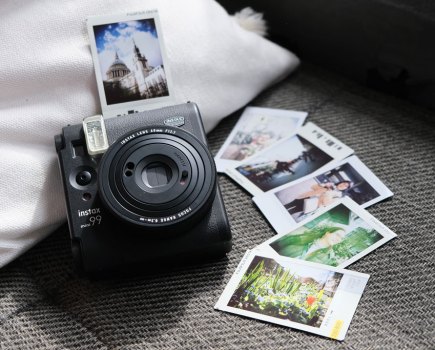Both the iPhone 16 Pro Max and the Samsung Galaxy S24 Ultra sit very definitively in our list of best smartphones for photographers. They both offer fantastic image quality and a range of other useful features for the photographically inclined, but of course, the question is which is best.
Here, I’ll be looking at how the iPhone 16 Pro Max compares with the Samsung Galaxy S24 Ultra by using them both in the same shooting scenarios. Don’t forget, the iPhone 16 Pro, with its smaller screen, uses the same camera setup as its larger sibling, so you could also consider it a comparison with that model too.
iPhone 16 Pro Max vs Samsung Galaxy S24 Ultra: Specs
In the table below, I’ve included the main specs that are likely to be of interest to the average photographer. I’ve bolded those which are – on the face of it at least – better, and as you’ll see there’s actually plenty of bold on both sides of the table.
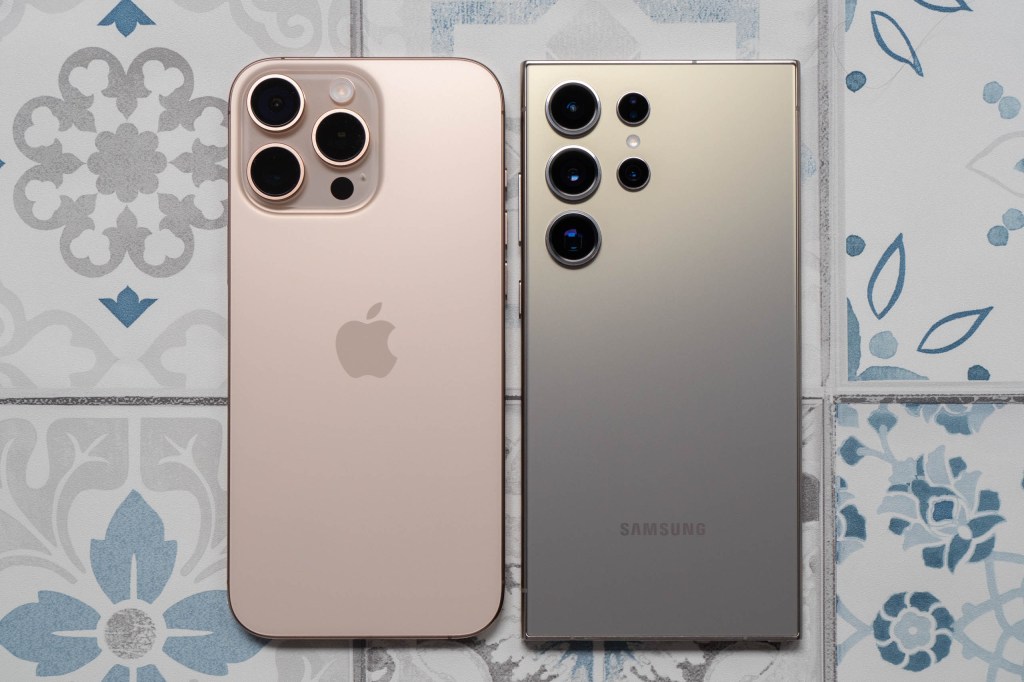
In terms of the cameras, you get four with the S24 Ultra, and only three with the iPhone 16 Pro Max. The main sensor for the S24 Ultra is a huge 200MP, while the iPhone’s is only 48MP – however it’s worth pointing out that the default output for the iPhone is 24MP, compared to 12MP for the Samsung.
Both have an ultrawide, but the iPhone 16 Pro Max has a higher resolution. For the third lens, we’ve got a 12MP 5x f/2.8 lens for the iPhone, or a 10MP 3x f/2.4 lens for the Samsung, so while the iPhone seems better there, there’s a fourth camera with the S24 Ultra giving you a 50MP 5x f/3.4 camera too.
| iPhone 16 Pro Max | Samsung Galaxy S24 Ultra |
|---|---|
| 48MP f/1.78 main camera, OIS, 24MP output, 24mmm | 200MP f/1.7 main camera, OIS, 12MP output, 24mm |
| 48MP f/2.2 ultrawide camera, 12MP output, 13mm | 12MP f/2.2 ultrawide camera, 13mm |
| 12MP f/2.8 5x telephoto camera, 120mm | 10MP f/2.4 3x telephoto camera, 67mm |
| No fourth camera | 50MP f/3.4, 5x telephoto camera, 111mm |
| 12MP f/1.9 selfie camera, AF | 12MP f/2.2 selfie camera, AF |
| 4K 120fps video | 8K 30fps |
| 6.9-inch XDR OLED Super Retina 2368 x 1320 pixels, 2000 nits brightness | 6.8-inch 3120 x 1440 pixels, 2600 nits brightness |
| Apple Intelligence (when available),A18 Pro processor | Qualcomm Snapdragon Gen 3 |
| 33 hour battery life,wireless and Fast (20W) charging available | 30 hour battery life, wireless and Fast (45W) charging available |
| 256/512/1TB storage | 256/512/1TB storage |
| 163 x 77.6 x 8.25mm, 227g | 162.3 x 79 x 8.6mm |
Elsewhere, take a look at those screens. Both are enormous, which you’ll either be happy about or you won’t. I used to think that the 6.8-inch Samsung S24 Ultra screen was a little on the ridiculous side, but Apple has topped even that with its 6.9-inch screen. The Samsung is brighter and higher resolution, though – and remember what they say, bigger isn’t always better anyway. It’s also important to note that despite the bigger screen, the iPhone is actually ever so slightly smaller than the Samsung.
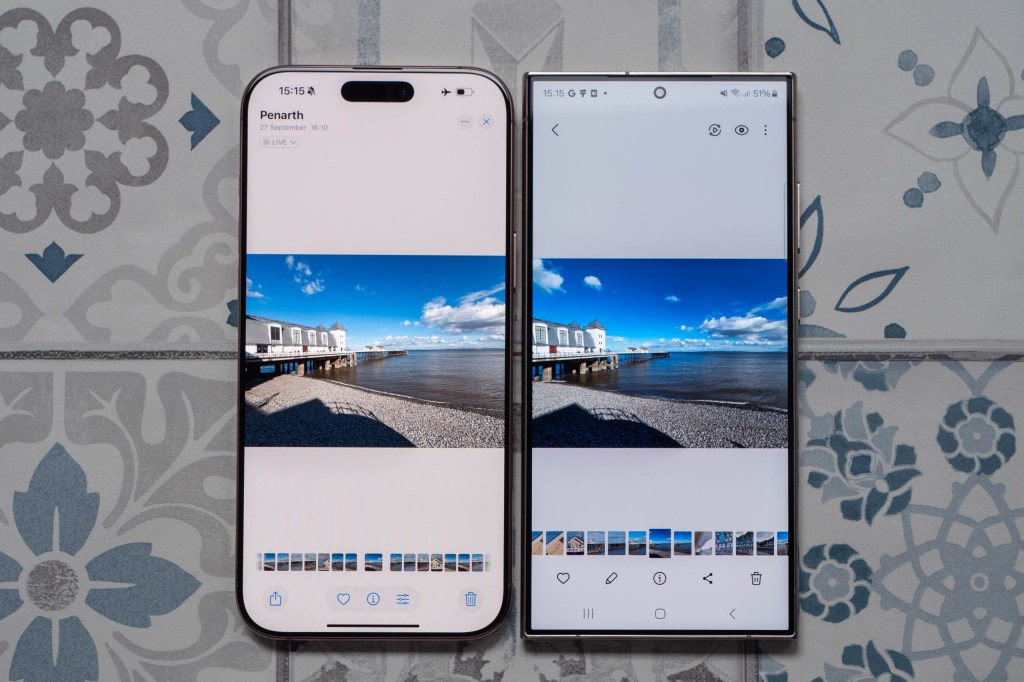
Handling wise, both of these phones being so large makes them a little cumbersome at times. However, it’s also true that your photos look great on such large screens. If you prefer something a little more pocket-friendly, you have the choice of the smaller iPhone 16 Pro, sadly there’s no direct equivalent for the Samsung.
A new feature of the iPhone 16 Pro Max is the addition of a “Camera Control” button, which gives you a physical way to not only release the shutter but also change other things, such as which lens you’re using and so on. The Samsung S24 Ultra comes with an S Pen stylus, which you can use to take notes, but more importantly for our purposes, it can also be used to remotely trigger the shutter. That can come in handy for selfies and so on.
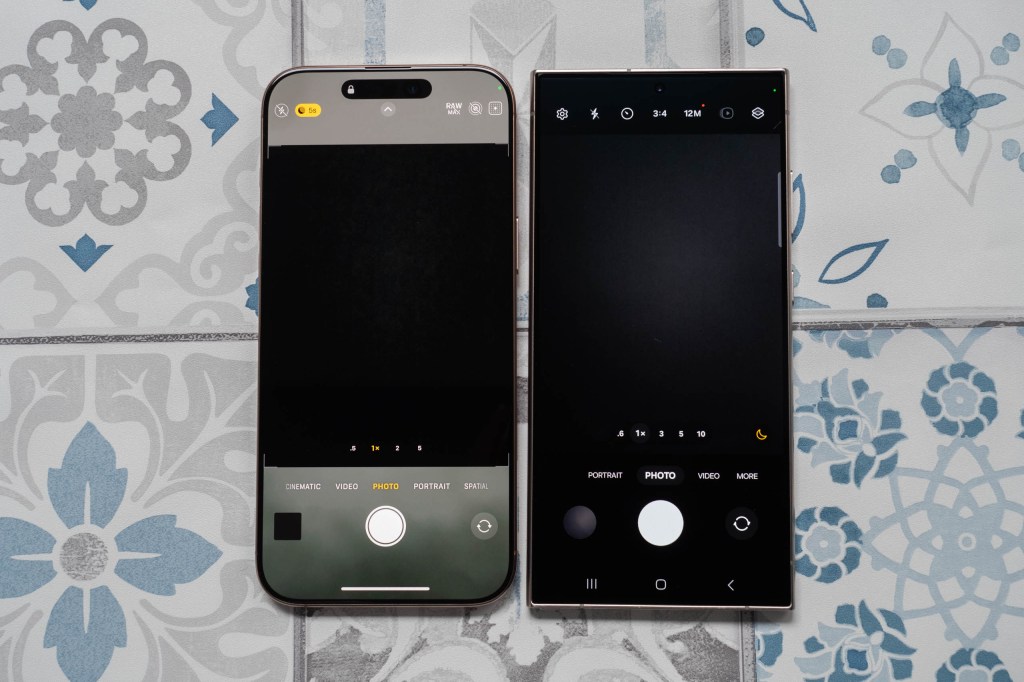
The iPhone’s native camera app is a little simpler than the Samsung’s, which has more options including a Pro mode and an ExpertRAW mode. There’s also more in the way of editing options with the Samsung at the moment – but Apple Intelligence is on the way so it should be a little more equal too.
Image Quality
I took photographs with both the iPhone 16 Pro Max and the Samsung Galaxy S24 Ultra across a variety of situations to directly compare image quality, and here are the results.
Note, the iPhone 16 Pro Max is on the left every time, and the S24 Ultra is on the right every time.


Images from both models are great, but we can see clearly here that the Samsung has produced a much more vibrant result – both of the images are taken with the 1x lens. Some might prefer that, but it’s safe to say that the iPhone image is a lot closer to reality than the Samsung. Both have plenty of detail, especially when looking at normal sizes on your phone screen, or for regular printing.


Now let’s look at the ultrawide. Here again the differences in colour between the two models are quite marked, with the sky much more vibrant in the Samsung version. Personally, I prefer the more realistic option but I can see why some would go for the brighter and more vivid picture. It’s worth noting that with the iPhone you could easily shoot in a different Photographic Style if you wanted to achieve the same kind of bold look. The iPhone 16 Pro Max image I would expect to have more detail considering it’s using a 48MP sensor vs a 12MP one, but in reality there’s no particularly observable difference when looking at normal sizes.


Here we see the Samsung’s 3x lens in action, but being as the iPhone doesn’t have one of those, I’ve compared it against the 2x option which is a selectable focal length in the iPhone’s native camera. This takes a crop from the centre of the 1x lens. They both do a pretty good job, albeit not being quite as good as those from either device’s 1x lens.


Both models offer a 5x zoom, but with some key differences (see spec table). Both produce respectable results when looking at the phone screen, but you do lose detail if you zoom in on either. With a narrower aperture, the Samsung’s lens may suffer more in low light – we’ll look at that in a bit.


Beyond the optical lenses, you also get digital zoom options with either model. The Samsung S24 Ultra goes up to a ridiculous 100x, while the iPhone 16 Pro Max tops out at 25x. The 100x option is all but unusable and is clearly intended as a marketing gimmick. 25x with either of them might just about come in useful if you were desperate, but 10x is about where I’d push the limits of either device so far. In the shots here, the Samsung has more detail, and again there’s the different colour. Both would be fine used at small sizes, so there’s not a huge amount in it.


Both the iPhone 16 Pro Max and the Samsung S24 Ultra use the ultrawide angle lens as the default macro option. Either phone lets you get pretty close to the subject and produces decent results. We’re seeing better from other phones on the market, but in terms of these two the Samsung is cleaner and brighter, so I’d give that one the edge just about.


Both the iPhone 16 Pro Max and the S24 Ultra produce great images in low light. You’ll get the best results with the 1x camera with either model. In our comparison here, the colours are probably more pleasing with the Samsung, but again, more accurate with the iPhone. However, there’s also more detail in the shadow areas of the iPhone.


With these images shot in low light using the ultrawide camera, I prefer the Samsung. The colours are nicer, and there’s more detail in the shadow areas. But they are both pretty good.


The iPhone’s 5x zoom lens has an equivalent of 120mm, compared to the Samsung’s 113mm, so its you just a little bit closer. Both are usable at small sizes on your iPhone, but they both show evidence of smudging if you look closely.


Beyond the 5x optical zoom from both cameras, you can use digital zooming, but I’d generally avoid this in low light situations where possible. If you can’t resist, the Samsung’s here at 10x is ever so marginally better, but neither are great shots. And it only gets worse from here with both models.


Both models here have a dedicated Portrait mode giving you the option to shoot at 1x, 3x or 5x with a blurred background. With the iPhone you have the added bonus of it automatically recognising a portrait subject and allowing you to convert it to a blurred background shot after the fact, even if you shoot in the regular Photo mode. In terms of the results, both are pretty good but the colours have been exaggerated a little too much for the Samsung, as well as losing some of the detail around the eyes. You therefore get better / more accurate skin tones with the iPhone (with this particular subject – other tones may vary) and so the result is overall more flattering.


Considering how important the selfie is in the modern era, it’s perhaps fair to say that both models have a bit of a disappointing set up. When I’ve looked at the best smartphones for cameras in the past, I’ve found other models on the market offer much better options. Regardless, between these two, the iPhone I think has created a more flattering effect with more pleasing skin tones. It’s also blurred the background more nicely, with a better drop off between subject and background.
Price and Value for Money
Neither of these models are for the budget conscious. As all of the above pictures could have been taken with the iPhone 16 Pro, you could bring your spend down if you’re happy with a smaller screen. Depending on where you are, you might find that the iPhone is cheaper, or, you might find that the Samsung is cheaper.
For the iPhone 16 Pro Max, the prices are $1199/£1199 (256GB), $1399/£1399 (512GB) or $1599/£1599 for 1TB. For the iPhone 16 Pro the prices are $999/£999 (128GB), $1099/£1099 (256GB), $1299/£1299 (512GB) and $1499/£1499 for 1TB.
By contrast, for the Samsung Galaxy S24 Ultra, it’s $1299/£1099 (256GB), $1419/£1199 (512GB) or $1659/£1399 (1TB).

You’re more likely to be able to find the Samsung already from second-hand retailers, having been out longer, so that’s worth considering.
Both of these brands hold their value well, but you’ll generally get more for an iPhone when it comes to resale, so that’s also something to think about too.
Verdict
It’s often hard to pick an outright winner when it comes to these vs pieces, and it remains true here.
Overall I prefer the more muted / realistic colours of the iPhone 16 Pro Max compared with the hyper realistic and saturated Samsung. But there will be plenty who feel the opposite – so to say one is better than the other is a difficult proposition.
Both produce good shots across a variety of situations from low light to portrait to macro. The Samsung has a better digital zoom than the iPhone’s, but it doesn’t generally produce usable images so that’s not really much to consider.
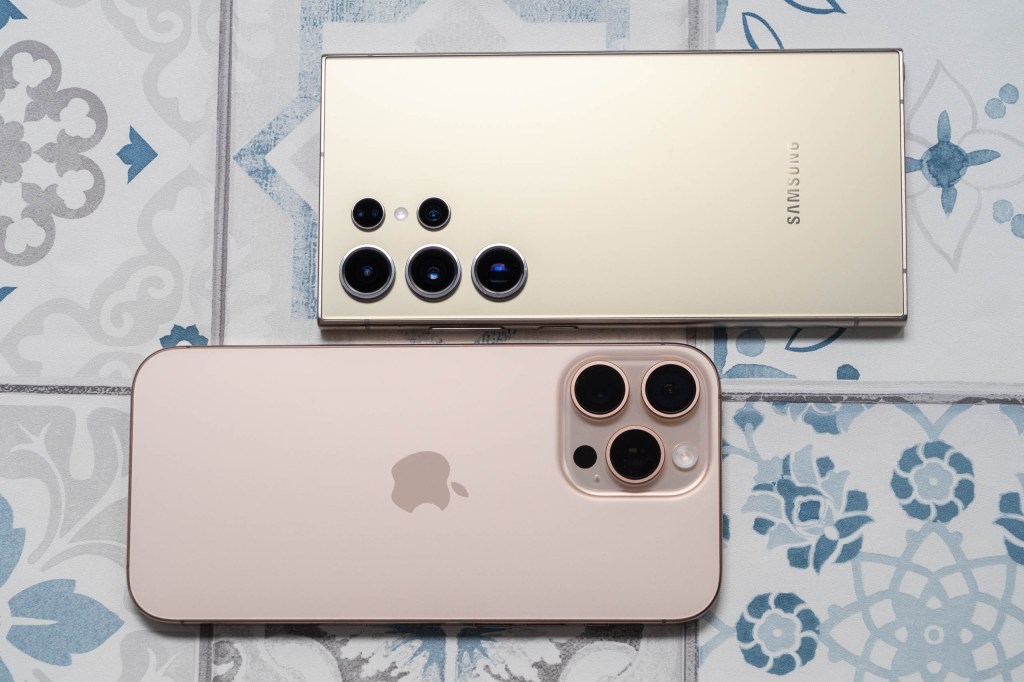
Elsewhere, you’ve got operating and handling. Some prefer iOS, some prefer Android. There’s more physical buttons you can use for the iPhone to control the camera, but the Samsung has an S Pen which you can use to remotely trigger the camera – and that comes in handy sometimes.
Both of them have ridiculously large screens, but an advantage of the iPhone system is that you can get the exact same camera in a smaller body.
And what about price – well in some markets the iPhone is cheaper, and some the Samsung is.
Essentially, we’re at a bit of a stalemate here – they’re both great at what they do, and you should be happy with either. Ultimately it likely comes down to whether you want to have an iOS phone or an Android one – if you’re resolutely stuck on either system then perhaps it won’t matter how good the rival is.
Read more smartphone comparisons:
- Best smartphones for photographers
- iPhone 16 Pro Max vs iPhone 15 Pro Max
- iPhone 15 Pro Max vs Samsung Galaxy S23 Ultra






